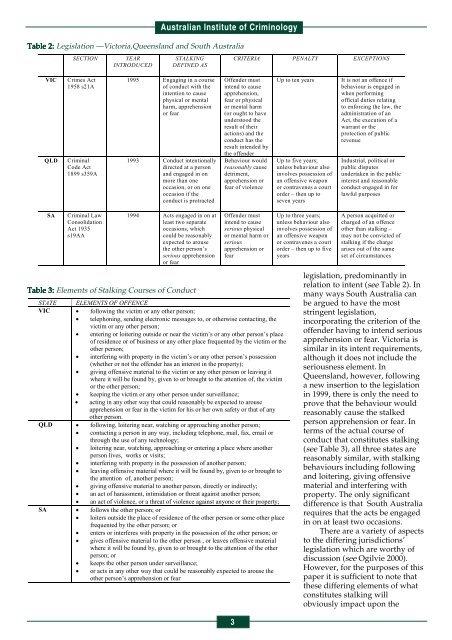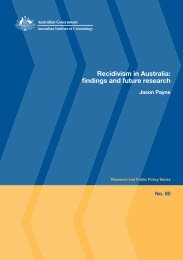Stalking : policing and prosecuting practices in three Australian ...
Stalking : policing and prosecuting practices in three Australian ...
Stalking : policing and prosecuting practices in three Australian ...
Create successful ePaper yourself
Turn your PDF publications into a flip-book with our unique Google optimized e-Paper software.
<strong>Australian</strong> Institute of Crim<strong>in</strong>ology<br />
Table Table 2: 2: 2: Legislation —Victoria,Queensl<strong>and</strong> <strong>and</strong> South Australia<br />
VIC Crimes Act<br />
1958 s21A<br />
QLD Crim<strong>in</strong>al<br />
Code Act<br />
1899 s359A<br />
SECTION YEAR<br />
INTRODUCED<br />
SA Crim<strong>in</strong>al Law<br />
Consolidation<br />
Act 1935<br />
s19AA<br />
STALKING<br />
DEFINED AS<br />
1995 Engag<strong>in</strong>g <strong>in</strong> a course<br />
of conduct with the<br />
<strong>in</strong>tention to cause<br />
physical or mental<br />
harm, apprehension<br />
or fear<br />
1993 Conduct <strong>in</strong>tentionally<br />
directed at a person<br />
<strong>and</strong> engaged <strong>in</strong> on<br />
more than one<br />
occasion, or on one<br />
occasion if the<br />
conduct is protracted<br />
1994 Acts engaged <strong>in</strong> on at<br />
least two separate<br />
occasions, which<br />
could be reasonably<br />
expected to arouse<br />
the other person’s<br />
serious apprehension<br />
or fear<br />
Table Table 3: 3: Elements of <strong>Stalk<strong>in</strong>g</strong> Courses of Conduct<br />
STATE ELEMENTS OF OFFENCE<br />
VIC • follow<strong>in</strong>g the victim or any other person;<br />
• telephon<strong>in</strong>g, send<strong>in</strong>g electronic messages to, or otherwise contact<strong>in</strong>g, the<br />
victim or any other person;<br />
• enter<strong>in</strong>g or loiter<strong>in</strong>g outside or near the victim’s or any other person’s place<br />
of residence or of bus<strong>in</strong>ess or any other place frequented by the victim or the<br />
other person;<br />
• <strong>in</strong>terfer<strong>in</strong>g with property <strong>in</strong> the victim’s or any other person’s possession<br />
(whether or not the offender has an <strong>in</strong>terest <strong>in</strong> the property);<br />
• giv<strong>in</strong>g offensive material to the victim or any other person or leav<strong>in</strong>g it<br />
where it will be found by, given to or brought to the attention of, the victim<br />
or the other person;<br />
• keep<strong>in</strong>g the victim or any other person under surveillance;<br />
• act<strong>in</strong>g <strong>in</strong> any other way that could reasonably be expected to arouse<br />
apprehension or fear <strong>in</strong> the victim for his or her own safety or that of any<br />
other person.<br />
QLD • follow<strong>in</strong>g, loiter<strong>in</strong>g near, watch<strong>in</strong>g or approach<strong>in</strong>g another person;<br />
• contact<strong>in</strong>g a person <strong>in</strong> any way, <strong>in</strong>clud<strong>in</strong>g telephone, mail, fax, email or<br />
through the use of any technology;<br />
• loiter<strong>in</strong>g near, watch<strong>in</strong>g, approach<strong>in</strong>g or enter<strong>in</strong>g a place where another<br />
person lives, works or visits;<br />
• <strong>in</strong>terfer<strong>in</strong>g with property <strong>in</strong> the possession of another person;<br />
• leav<strong>in</strong>g offensive material where it will be found by, given to or brought to<br />
the attention of, another person;<br />
• giv<strong>in</strong>g offensive material to another person, directly or <strong>in</strong>directly;<br />
• an act of harassment, <strong>in</strong>timidation or threat aga<strong>in</strong>st another person;<br />
• an act of violence, or a threat of violence aga<strong>in</strong>st anyone or their property;<br />
SA • follows the other person; or<br />
• loiters outside the place of residence of the other person or some other place<br />
frequented by the other person; or<br />
• enters or <strong>in</strong>terferes with property <strong>in</strong> the possession of the other person; or<br />
• gives offensive material to the other person , or leaves offensive material<br />
where it will be found by, given to or brought to the attention of the other<br />
person; or<br />
• keeps the other person under surveillance;<br />
• or acts <strong>in</strong> any other way that could be reasonably expected to arouse the<br />
other person’s apprehension or fear<br />
3<br />
CRITERIA PENALTY EXCEPTIONS<br />
Offender must<br />
<strong>in</strong>tend to cause<br />
apprehension,<br />
fear or physical<br />
or mental harm<br />
(or ought to have<br />
understood the<br />
result of their<br />
actions) <strong>and</strong> the<br />
conduct has the<br />
result <strong>in</strong>tended by<br />
the offender<br />
Behaviour would<br />
reasonably cause<br />
detriment,<br />
apprehension or<br />
fear of violence<br />
Offender must<br />
<strong>in</strong>tend to cause<br />
serious physical<br />
or mental harm or<br />
serious<br />
apprehension or<br />
fear<br />
Up to ten years It is not an offence if<br />
behaviour is engaged <strong>in</strong><br />
when perform<strong>in</strong>g<br />
official duties relat<strong>in</strong>g<br />
to enforc<strong>in</strong>g the law, the<br />
adm<strong>in</strong>istration of an<br />
Act, the execution of a<br />
warrant or the<br />
protection of public<br />
revenue<br />
Up to five years;<br />
unless behaviour also<br />
<strong>in</strong>volves possession of<br />
an offensive weapon<br />
or contravenes a court<br />
order – then up to<br />
seven years<br />
Up to <strong>three</strong> years;<br />
unless behaviour also<br />
<strong>in</strong>volves possession of<br />
an offensive weapon<br />
or contravenes a court<br />
order – then up to five<br />
years<br />
Industrial, political or<br />
public disputes<br />
undertaken <strong>in</strong> the public<br />
<strong>in</strong>terest <strong>and</strong> reasonable<br />
conduct engaged <strong>in</strong> for<br />
lawful purposes<br />
A person acquitted or<br />
charged of an offence<br />
other than stalk<strong>in</strong>g –<br />
may not be convicted of<br />
stalk<strong>in</strong>g if the charge<br />
arises out of the same<br />
set of circumstances<br />
legislation, predom<strong>in</strong>antly <strong>in</strong><br />
relation to <strong>in</strong>tent (see Table 2). In<br />
many ways South Australia can<br />
be argued to have the most<br />
str<strong>in</strong>gent legislation,<br />
<strong>in</strong>corporat<strong>in</strong>g the criterion of the<br />
offender hav<strong>in</strong>g to <strong>in</strong>tend serious<br />
apprehension or fear. Victoria is<br />
similar <strong>in</strong> its <strong>in</strong>tent requirements,<br />
although it does not <strong>in</strong>clude the<br />
seriousness element. In<br />
Queensl<strong>and</strong>, however, follow<strong>in</strong>g<br />
a new <strong>in</strong>sertion to the legislation<br />
<strong>in</strong> 1999, there is only the need to<br />
prove that the behaviour would<br />
reasonably cause the stalked<br />
person apprehension or fear. In<br />
terms of the actual course of<br />
conduct that constitutes stalk<strong>in</strong>g<br />
(see Table 3), all <strong>three</strong> states are<br />
reasonably similar, with stalk<strong>in</strong>g<br />
behaviours <strong>in</strong>clud<strong>in</strong>g follow<strong>in</strong>g<br />
<strong>and</strong> loiter<strong>in</strong>g, giv<strong>in</strong>g offensive<br />
material <strong>and</strong> <strong>in</strong>terfer<strong>in</strong>g with<br />
property. The only significant<br />
difference is that South Australia<br />
requires that the acts be engaged<br />
<strong>in</strong> on at least two occasions.<br />
There are a variety of aspects<br />
to the differ<strong>in</strong>g jurisdictions’<br />
legislation which are worthy of<br />
discussion (see Ogilvie 2000).<br />
However, for the purposes of this<br />
paper it is sufficient to note that<br />
these differ<strong>in</strong>g elements of what<br />
constitutes stalk<strong>in</strong>g will<br />
obviously impact upon the















